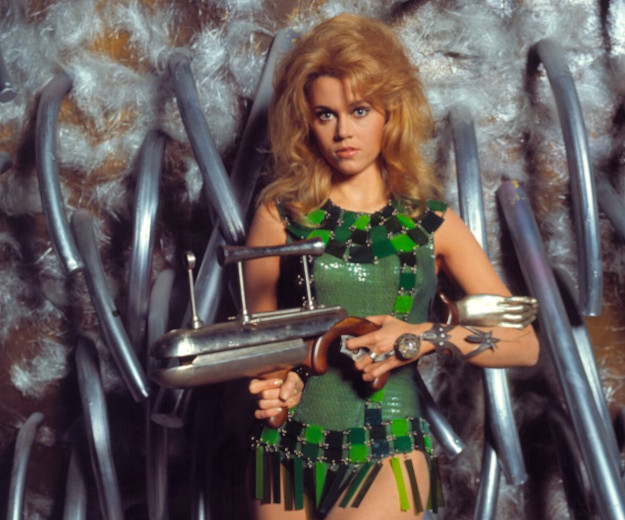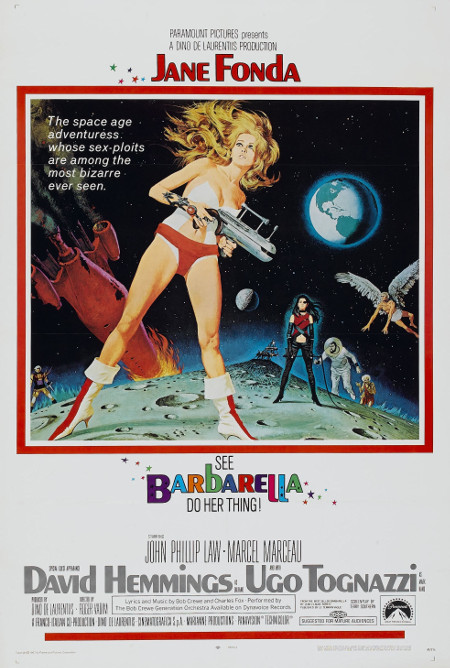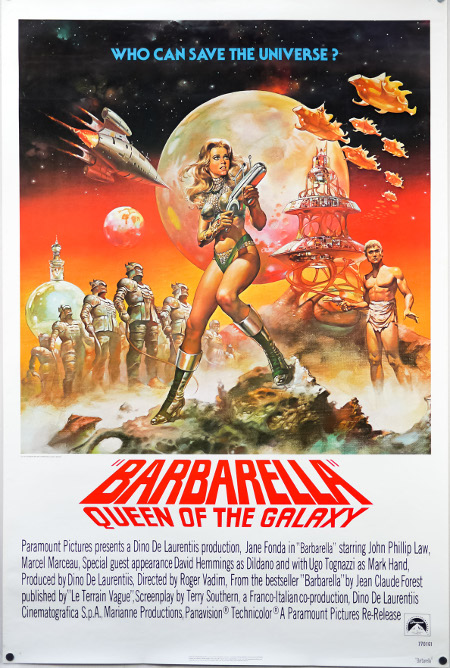Like an episode of Star Trek on Viagra, 1968’s Barbarella is an exploitative romp in space, a journey that will take you far past the gaseous crevices of Uranus and into another sci-fi tinged dimension.
Written by a pair of era icons (and seven other collaborators), two time Oscar nominee Terry Southern and Roger Vadim (also the director), you will likely never see another movie have an opening credits sequence like this one – a 401st century astronaut, Barbarella (Jane Fonda – Vadim’s wife at the time), slowly removes her spacesuit whilst floating in a gravity-less craft. . . a most sultry, slow-motion striptease (the effect was achieved by having Fonda lie on a large piece of plexiglass with an image of the spaceship underneath her. . . filmed from above, it flawlessly reenacts the semblance of zero gravity).
Receiving a transmission from Earth, the planet’s President (Claude Dauphin) gives Barbarella a most pressing task – to track down a maniacal inventor named Dr. Durand Durand (this was where the iconic 1980s band Duran Duran got their name from) who has built a death ray. A planetary system that has been at peace for eons, it is a shock that this most recent threat has popped up. . . but this vile man, ‘hungry like the wolf’ (sorry, had to), is driven by an innate desire to conquer and control Earth – destruction no problem, as long as he gains power.
Armed with an array of weapons that could second as sex toys, the wide-eyed, inexperienced space-traveller crash lands on a distant planet rumoured to house the evil doctor, finding herself on an ice field surrounded by a bevy of eerie children (somewhat like the fraternal discards of the kids found in the film Village of the Damned). Terrorizing her with dolls that have Jaws-like metal teeth (and I mean a hybrid of the Bond villain and the shark), she is rescued by patrolman Mark Hand (Ugo Tognazzi), a loner with the skills to fix her ship (and chest hair that could rival Sean Connery’s).
Repaying the man with a roll in the hay (not the 401st century way – which consists of a pill and hand touching, but rather, the good old fashioned way), this continues a trend that was hinted at from the very beginning (with the President also wanting to ‘palm’ the dame). . . it is quite clear that no one can resist the sultry astronaut.
Finding her way to a labyrinth positioned outside of the evil city of Sogo, it is here that she meets a blind angel, Pygar (John Phillip Law) – who has lost his will to fly, and the extremely intelligent Professor Ping (Marcel Marceau – yes, the mime actually speaks), two newfound friends that will aid her in her challenging conquest. Of course, Pygar quickly gets his wings functioning after Barbarella services him (wink wink, nudge nudge), and he is able to fly her above the hopeless maze and into the vile city.
Meeting the likes of the Black Queen (Anita Pallenberg), her conniving Concierge (Milo O’Shea), and a leader of the underground with the unflattering name of Dildano (David Hemmings) – he is a bit of a tool, Barbarella must tread carefully if she is to unearth Durand Durand and discover his diabolical weapon (we all know he has ‘a view to a kill’). She will come face to face with the most unimaginable challenges – including the biting bird cage, the chamber of dreams, and the palace of pleasure. Will Barbarella be able to save the day, defeating pure evil with her unique combination of firepower, see-through attire, one night stands and 401st century viewpoint of peace and love?
A highly bizarre film, I will immediately warn readers that this will be a rare review that does not obtain a 7.0 or higher. . . as it is not the greatest of films, though it does have a certain historic value, while its uniquely bizarre originality makes it a fun watch. So very exploitative (and so very sixties), it oozes that hippie sentiment, while Barbarella’s spacecraft, which features floor to ceiling shag carpets, will only further reinforce this most interesting period in history. Probably best enjoyed whilst on drugs (not endorsed by Filmizon.com), it has a loose, meandering, episodic story (Barbarella faces one test after another with little direction or connection), while its strengths are its kitschy visual style (very reminiscent of Star Trek), its take on the future (no sex, no body shame, peace not war), and its James Bond-like female astronaut (girls want to be her, men want to be with her) – making the story so much fun. Its soundtrack-driven music (written by Bob Crewe and Charles Fox) finds itself somewhere between Petula Clark and psychedelic pop/rock, an entertaining backdrop for an already weird feature. Funnily enough, the motion picture actually did very well, especially in the United Kingdom, where it was the second highest grossing film of the year (behind only The Jungle Book).
To touch on a bit of re-release history here, Barbarella was put back into theatres in 1977. . . why? . . . because studios were trying to capitalize on the Star Wars craze. Editing out the nudity and adding ‘Queen Of The Galaxy’ to the title, a beautiful poster was designed in the style of the George Lucas movie, check both posters out below (as they are each intriguing in their own way).
Perhaps the film’s most iconic scene, along with the opening, is when Barbarella is placed in the Excessive Pleasure Machine (a tool used to pleasure people to death), though the woman is so erotic that she makes it explode. This is, after all, a perfect summary of the picture as a whole – a campy, sex-driven sci-fi romp that is quirky and entertaining, though flawed, never wholly satisfying. As a last sidenote, the director of photography was Claude Renoir, son of actor Pierre Renoir, nephew of director Jean Renoir, and grandson of impressionist painter Pierre-Auguste Renoir. Released during the original run of Star Trek, the same year as 2001: A Space Odyssey and re-released the same year as Star Wars, Barbarella is an entirely different galactic experience, a memory of a bygone era set 38,000 years into the future.




